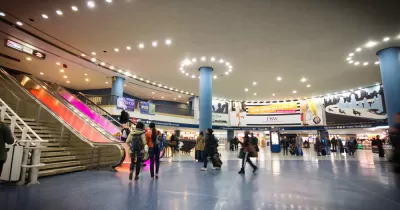At best, it will take seven years to build the Amtrak Gateway tunnels, the replacement of Access to the Region's Core. If one of the existing two aging tunnels has to be shut to make repairs before the project is completed, commute nightmare ensues.

"Amtrak officials are in a race against time to avoid a commuting nightmare if one of the existing 100-year old tunnels has to be closed for major repairs before new (Hudson River) tunnels are built," writes Larry Higgs of NJ Advance Media for NJ.com on the calamity facing NJ Transit commuter and Amtrak's Northeast Corridor passengers accessing New York's Penn Station from New Jersey.
Train traffic would slow to a trickle, from an average of 24 to 6 trains per hour if one of the existing tunnels had to be closed. About 400 NJ Transit commuter trains a day travel through the existing tunnels, said (Amtrak president Joseph Boardman during an interview with the Star Ledger editorial board).
As we noted last month, the need to close one of the tunnels for repairs was hastened after "Amtrak released a report (in September) finding that 'salt left behind by Hurricane Sandy’s floodwaters continues to weaken the tunnels’ concrete and corrode its cast iron and steel'." The findings also impact LIRR commuters accessing Penn Station.
Cost for the Amtrak Gateway "and several allied projects to New York could cost an estimated $16 billion and under the most optimistic scenario could take up to a decade to build," writes Higgins. And the cost won't be borne only by the region's commuters. "The regional economy could lose $100 million a day in economic activity, due to a shut down, Boardman said."
An estimated 50 and 80 percent [sic] of the Gateway tunnel project funding should come from the federal government, with the remainder to be divided between New Jersey, New York and Amtrak, Boardman said. The Gateway Project [PDF] includes two new tunnels under the Hudson, adding two new tracks along the corridor in New Jersey south of Newark, and construction an [sic] annex [aka Moynihan Station] to New York's Penn Station to handle additional trains.
Last month, Higgins wrote, "To do the major repair work, one tube of the two [existing] Hudson River tunnels would have to be shut down for a year, which would have severe impact on the 450 trains a day which use the tunnels. Anthony Coscia, chairman of Amtrak's board of directors, said that can only happen if the Gateway Tunnel project is built first, which would allow Amtrak to take one of the old tunnels out of service without reducing the number of trains it and NJ Transit run.
FULL STORY: Build $16B Hudson tunnel project or economy could lose $100M a day, Amtrak says

Study: Maui’s Plan to Convert Vacation Rentals to Long-Term Housing Could Cause Nearly $1 Billion Economic Loss
The plan would reduce visitor accommodation by 25,% resulting in 1,900 jobs lost.

North Texas Transit Leaders Tout Benefits of TOD for Growing Region
At a summit focused on transit-oriented development, policymakers discussed how North Texas’ expanded light rail system can serve as a tool for economic growth.

Why Should We Subsidize Public Transportation?
Many public transit agencies face financial stress due to rising costs, declining fare revenue, and declining subsidies. Transit advocates must provide a strong business case for increasing public transit funding.

How to Make US Trains Faster
Changes to boarding platforms and a switch to electric trains could improve U.S. passenger rail service without the added cost of high-speed rail.

Columbia’s Revitalized ‘Loop’ Is a Hub for Local Entrepreneurs
A focus on small businesses is helping a commercial corridor in Columbia, Missouri thrive.

Invasive Insect Threatens Minnesota’s Ash Forests
The Emerald Ash Borer is a rapidly spreading invasive pest threatening Minnesota’s ash trees, and homeowners are encouraged to plant diverse replacement species, avoid moving ash firewood, and monitor for signs of infestation.
Urban Design for Planners 1: Software Tools
This six-course series explores essential urban design concepts using open source software and equips planners with the tools they need to participate fully in the urban design process.
Planning for Universal Design
Learn the tools for implementing Universal Design in planning regulations.
City of Santa Clarita
Ascent Environmental
Institute for Housing and Urban Development Studies (IHS)
City of Grandview
Harvard GSD Executive Education
Toledo-Lucas County Plan Commissions
Salt Lake City
NYU Wagner Graduate School of Public Service


























